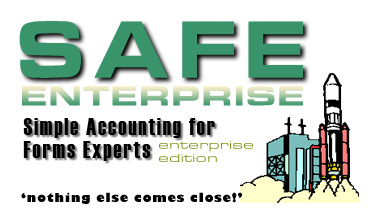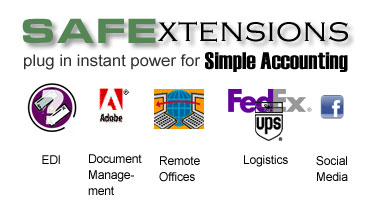Sites & Quantities For S/O Line Items
 This screen is where you enter and edit the source (Ship From) and destination (Ship To) addresses and the quantities to order and ship. It is opened from the Sites & Quantities Browse Box within each Sales Order Line Item. Since each Site (shipping address) may also be in a separate sales tax jurisdiction, this is also the place where you select the proper Sales Tax ID for each site.
This screen is where you enter and edit the source (Ship From) and destination (Ship To) addresses and the quantities to order and ship. It is opened from the Sites & Quantities Browse Box within each Sales Order Line Item. Since each Site (shipping address) may also be in a separate sales tax jurisdiction, this is also the place where you select the proper Sales Tax ID for each site.
 Selecting Alternate Ship To Addresses
Selecting Alternate Ship To Addresses
By default, each item is set to automatically ship to the selected customers bill-to address set in FILES|Customers. To select a different shipping address (SITE), press the [SITE] button. A browse is available to select alternate shipping addresses (or add new sites for this customer.)
You may also select one of the selected Vendors alternate shipping addresses. This automatically places the shipped quantity in off-line storage at that vendors warehouse.
 This button lets you select a separate contact to serve as the Attention Line for each Shipping Address (SITE) on a sales order. If you do not select a contact, the default Contact Name field for the selected Shipping Address (SITE) is used. Normally the attention line consists of the contact person you have entered as the default for the shipping address. Pressing this button allows you to select any contact linked to that particular customer.
This button lets you select a separate contact to serve as the Attention Line for each Shipping Address (SITE) on a sales order. If you do not select a contact, the default Contact Name field for the selected Shipping Address (SITE) is used. Normally the attention line consists of the contact person you have entered as the default for the shipping address. Pressing this button allows you to select any contact linked to that particular customer.
 Selecting Alternate Ship-From Addresses
Selecting Alternate Ship-From Addresses
The site where the product will ship from, (ie. the source point) defaults to the DEFAULT SHIPPING ADDRESS set in the . If the source is in your (distributor) warehouse, you must select your company as the Ship From Site. To select a different site, press the [Ship From] button.
An item can ship from any customer or vendor location as necessary. This makes it easy to transfer product between customer sites, or to ship from an alternate vendor. You can specify an alternate location to ship the product from if the item can be delivered from multiple points, or is kept in off-line storage at multiple warehouses.
F.O.B. Enter the source from which this order will be shipped.
FREIGHT MARK UP Indicates how freight costs are passed on to the customer.
Yes Freight cost passed on to customer plus a mark up formula.
No Freight cost passed on to customer with no mark up.
Include Freight cost not passed on to customer.
 The Freight Mark Up Formula is set in Security Extensions under the Custom Settings Menu.
The Freight Mark Up Formula is set in Security Extensions under the Custom Settings Menu.
C Customer pays for the freight. The amount you enter as Freight Expense is automatically entered into the Freight Price field of each line item.
I Included with the sale. Freight Cost is not automatically passed on to the customer.
V Vendor pays for freight. Cost is passed through to customer.
If you have Security Extensions, you can disable the data entry persons ability to override your mark up formulas.
If you have Security Extensions, you can also create a custom formula which is automatically marks up freight for the Freight Price field.
|
FREIGHT EXPENSE |
Normally, the cost of goods is the only expense associated with sales of most items. However, you may have need to enter an additional cost for certain items. This field allows for entering such an expense. Any expenses here are factored into the item’s profit in sales history. Example: If the sale is for $1000.00 and the cost of goods is 700.00 and the miscellaneous expense is 50.00, the profit on this item will be recorded as $250.00. If the SHIPPING TYPE in the header is either ‘I’ or ‘C’, the program assumes that any shipping revenue you charge the customer for is a pass-through from a vendor’s freight charge to you. In both cases, the dollar amount you enter into the SHIPPING$ field is automatically entered into the MISCELLANEOUS EXPENSE of the first line item on the order.
|
|
EXPENSE ACCOUNT |
If a non-zero number is entered into the FREIGHT EXPENSE field, you must enter the proper G/L account here to which the cost will be allocated. A field lookup button is available to help select. The default account is your FREIGHT EXPENSE ACCOUNT selected in Setup Global Options. This account represents freight you have paid the vendor for the item. You can also select other accounts, for example a Finder’s Fee account, to hold commissions to be paid to the finder which is included in the sale price, but which is not in the profit. If this is a non-stock item, this amount will be posted as a separate line item on the vendor invoice automatically generated for you when you print the customer invoice.
|
|
FREIGHT PRICE |
Enter the amount you will be charging the customer for delivery of this item. If the FREIGHT MARK UP is set to Yes or No, the FREIGHT EXPENSE field will automatically be filled in for you with the same amount (or a Mark Up as described in the FREIGHT MARK UP field).
|
|
ORDER QTY |
Enter the quantity of items ordered, up to 99,999.999. TIP: You can also enter the Order Quantity using Edit In Place in the previous Sales Order Line Item window. We only recommend you do this, however, on orders where the defaults for the remaining fields (Sales Tax ID, Ship To, Ship From, etc.) are correct.
|
|
SHIP QTY |
Enter quantity to be shipped (today) up to 999,999.999. Only orders with items that will be shipped (today) can be invoiced. An order which has all items back-ordered will not be invoiced. Only shipped quantities will appear on Packing Slips. Package Quantities are available only for display purposes. They will only appear on invoices, P.O.s, etc if your invoices are formatted by Suntower Systems to provide this feature. Otherwise, these forms will print only the regular unit price and unit of measure.
|
|
If the Minimum Reorder Level is set to any number for the selected product and that product is marked as Inventoried, you are warned if the Ship Quantity is greater than the amount on hand for that product.
|
|
|
SALES TAX ID |
You must enter a valid Tax ID for each Shipping Location from the Sales Tax Browse. The default will be the ID you have assigned to this customer in The Customer Master unless you have assigned this order an Alternate Shipping Address. If this is the case, then the Tax ID defaults to the Sales Tax ID you entered for that shipping address. After you enter this field, the selected Sales Tax Percentage for this order is displayed to the right of the Sales Tax ID.
|
|
Enter the carrier who will be delivering this order. The default is this customers default SHIP VIA, but may be overridden by press the field lookup button.
|
|
|
LOT NUMBER |
Allows you to select an alternate Lot to draw the Product from (this only applies if you have LIFO or FIFO costing selected in Setup A/P & Purchasing Options.) By default Simple Accounting chooses the correct Lot for you, but you may use the field lookup button to select an alternate Lot if available. Important Note: Selecting an alternate Lot, selects the Ship From Address for that Lot!
|
|
TRACKING ID |
Enter the shippers bill-of-lading number. Right clicking on this field can be programmed to automatically launch the tracking web page for the selected carrier. Please contact Suntower Systems for more information.
|
|
SERIAL NUMBER |
You can enter a Serial Number for any Product you are selling. If the item is part of a Purchase Order, then the Serial Number is added to a list of available numbers. If the Line Item type is Release then the Serial Number is marked as having been used so that it may not be applied to any other transaction. |
 CONTACTS TO DELIVER TO AT THIS LOCATION
CONTACTS TO DELIVER TO AT THIS LOCATION
You may need to track usage for more than one individual at a particular location. For example, there may be five people at a bank branch for which you need to track usage separately.
This browse box allows you to do this by selecting one or more contacts to be specified for delivery at this Shipping Address. If you use this browse, you can no longer enter the ordered or ship quantities directly into the ORDERED and SHIPPED fields for the line item. Instead you enter the ordered and ship quantities for each contact. The advantage here is for applications where you are shipping several different lots to one shipping address for more than one individual. For example, ship 1,000 labels to Fred in Marketing and 1,000 to Donna in Sales.
These contacts must be pre assigned to this shipping site. Do this from the Shipping Address browse from within the Customer Browse.
 Never Attempt To Mix Lots On One Sales Order Line Item as this could lead to incorrect costing. Why? Consider the following example: You have a single line item which must ship to
Never Attempt To Mix Lots On One Sales Order Line Item as this could lead to incorrect costing. Why? Consider the following example: You have a single line item which must ship to 



 This button activates a [tooltip slug="browse-box"]browse box[/tooltip]. It is always placed directly to the right of an entry field and allows you to select a value for the entry field from the browse box. The browse box usually has all the same functions as if you had selected it from the main menu, so you can add, edit or delete records in the browse without leaving your original task.
This button activates a [tooltip slug="browse-box"]browse box[/tooltip]. It is always placed directly to the right of an entry field and allows you to select a value for the entry field from the browse box. The browse box usually has all the same functions as if you had selected it from the main menu, so you can add, edit or delete records in the browse without leaving your original task. Pressing <F6> on your keyboard when you are in a field with a lookup button works the same as pressing the Field Lookup button itself!
Pressing <F6> on your keyboard when you are in a field with a lookup button works the same as pressing the Field Lookup button itself!